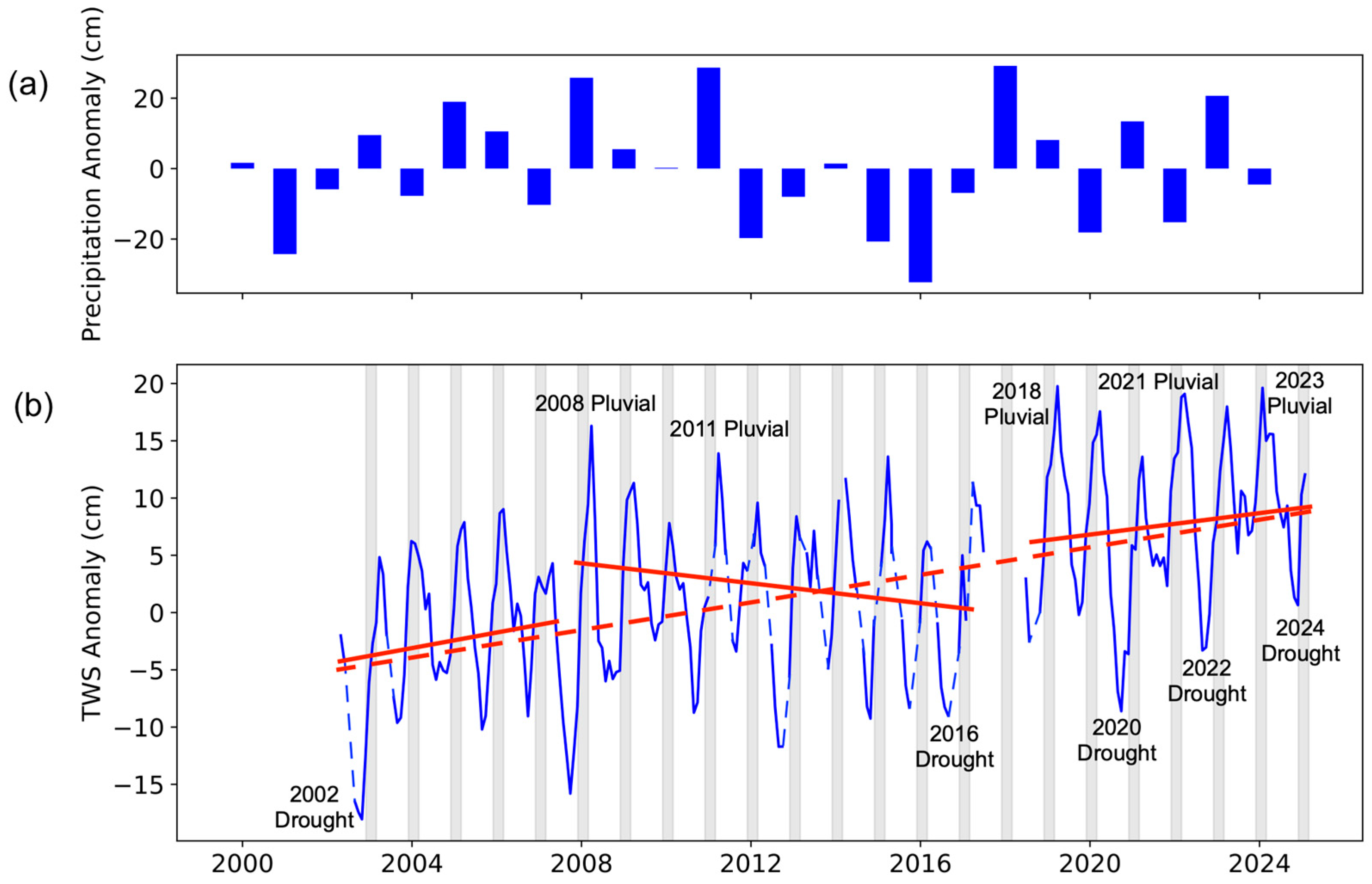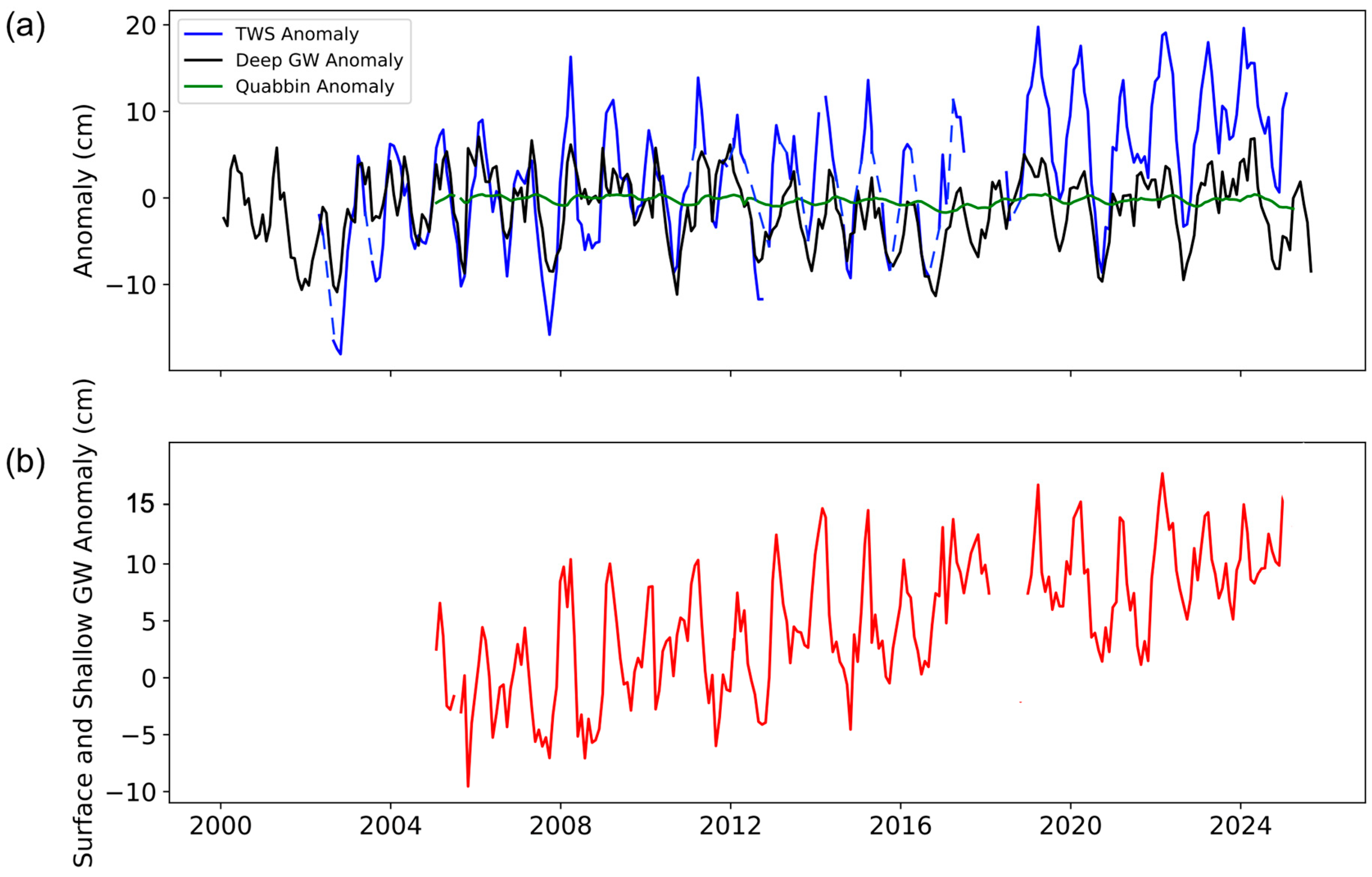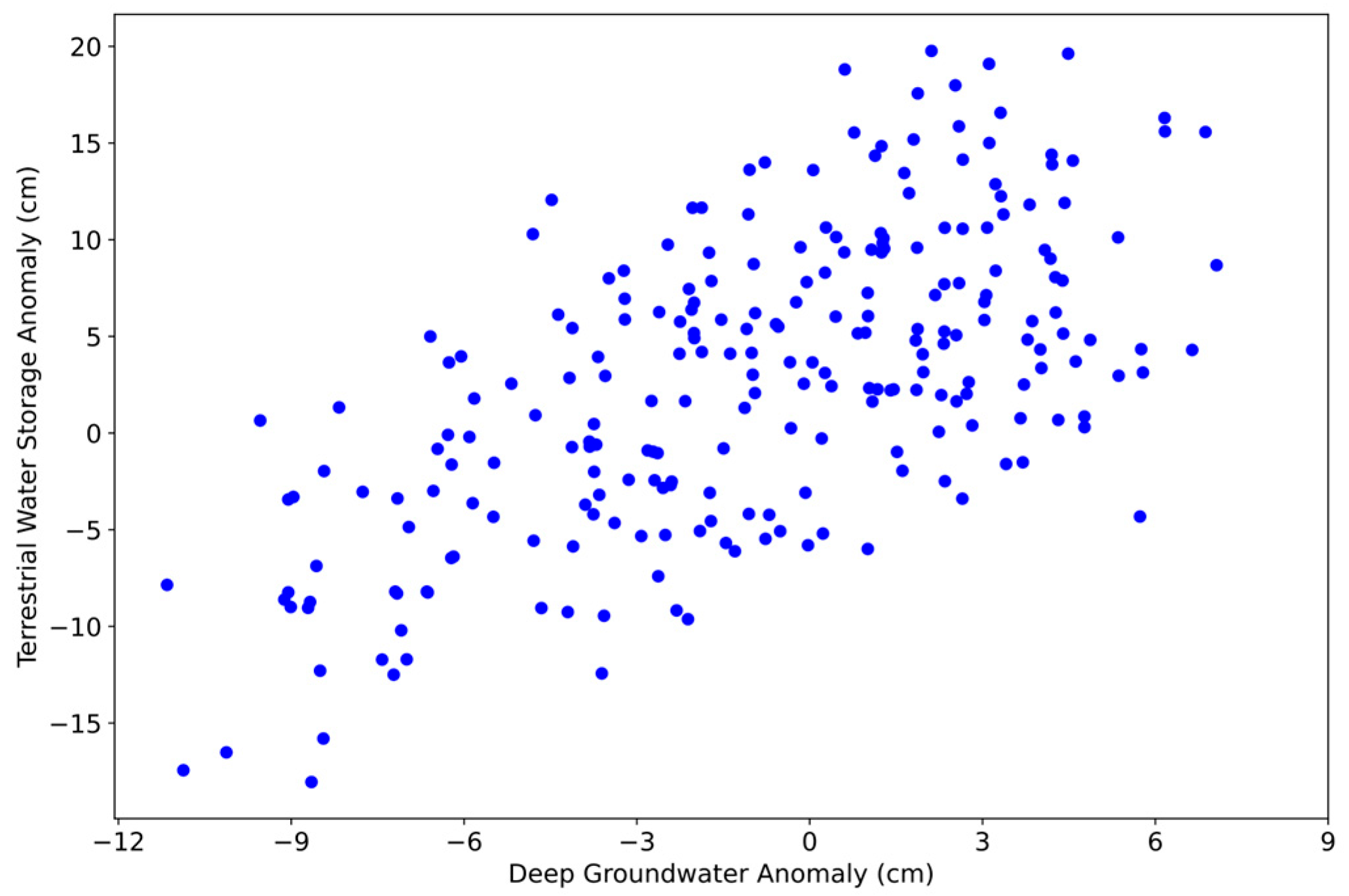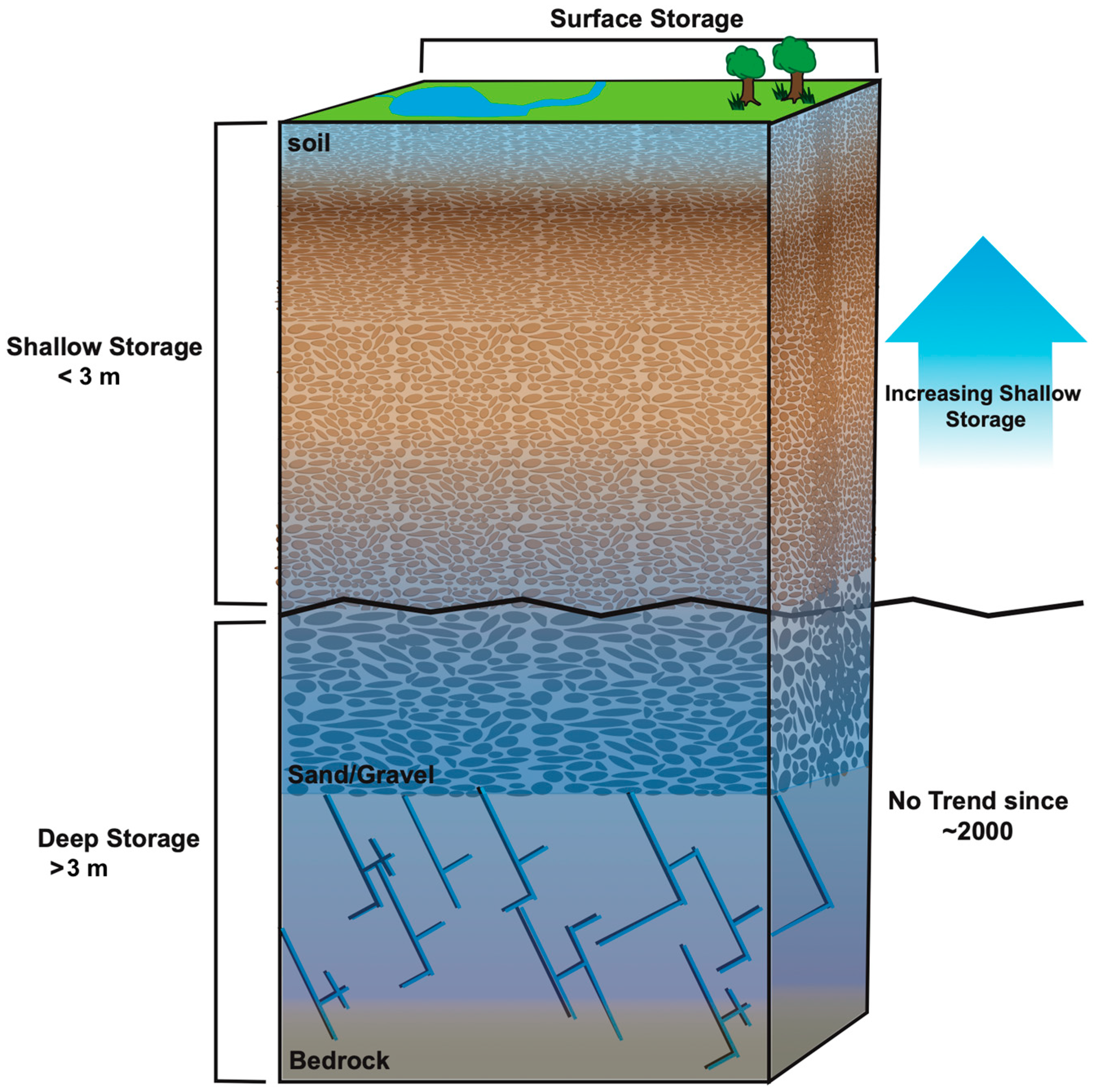The Decadal Increase in Terrestrial Water Storage in a Region Experiencing Rapid Transitions from Dry to Wet Periods
Abstract
1. Introduction
- Documenting how these data have changed over time;
- Comparing their respective increases and decreases;
- Characterizing the impacts of recent pluvials and droughts.
2. Study Area
2.1. Regional Geology
2.2. Regional Climate and Hydrology

3. Materials and Methods
3.1. Definition of Subsurface Storage Reservoirs
3.2. GRACE Terrestrial Water Storage Data Retrieval
3.3. USGS Monitoring Well Data Retrieval
3.4. Quabbin Reservoir Data Retrieval
3.5. SMAP Soil Moisture Data Retrieval
4. Results
4.1. Terrestrial Water Storage (GRACE)
4.2. Groundwater (USGS Monitoring Wells)
4.3. Surface and Shallow Groundwater Residual
4.4. Soil Moisture (SMAP)
5. Discussion
6. Conclusions
Supplementary Materials
Author Contributions
Funding
Data Availability Statement
Acknowledgments
Conflicts of Interest
Abbreviations
| USGS | United States Geological Survey |
| NASA | National Aeronautics and Space Administration |
| GRACE | Gravity Recovery and Climate Experiment |
| CRI | Coastal Resolution Improvement |
| DTW | Depth to Water |
| NWIS | National Water Information System |
| SMAP | Soil Moisture Active Passive |
References
- Oki, T.; Kanae, S. Global hydrological cycles and world water resources. Science 2006, 313, 1068–1072. [Google Scholar] [CrossRef]
- Wu, P.; Christidis, N.; Stott, P. Anthropogenic impact on Earth’s hydrological cycle. Nat. Clim. Change 2013, 3, 807–810. [Google Scholar] [CrossRef]
- Yin, J.; Gentine, P.; Zhou, S.; Sullivan, S.C.; Wang, R.; Zhang, Y.; Guo, S. Large increase in global storm runoff extremes driven by climate and anthropogenic changes. Nat. Commun. 2018, 9, 4389. [Google Scholar] [CrossRef]
- Allan, R.P.; Barlow, M.; Byrne, M.P.; Cherchi, A.; Douville, H.; Fowler, H.J.; Gan, T.Y.; Pendergrass, A.G.; Rosenfeld, D.; Swann, A.L.S.; et al. Advances in understanding large-scale responses of the water cycle to climate change. Ann. N. Y. Acad. Sci. 2020, 1472, 49–75. [Google Scholar] [CrossRef]
- Fowler, H.J.; Lenderink, G.; Prein, A.F.; Westra, S.; Allan, R.P.; Ban, N.; Barbero, R.; Berg, P.; Blenkinsop, S.; Do, H.X.; et al. Anthropogenic intensification of short-duration rainfall extremes. Nat. Rev. Earth Environ. 2021, 2, 107–122. [Google Scholar] [CrossRef]
- Chandanpurkar, H.A.; Famiglietti, J.S.; Gopalan, K.; Wiese, D.N.; Wada, Y.; Kakinuma, K.; Reager, J.T.; Zhang, F. Unprecedented continental drying, shrinking freshwater availability, and increasing land contributions to sea level rise. Sci. Adv. 2025, 11, eadx0298. [Google Scholar] [CrossRef] [PubMed]
- Liu, Q.; Bader, J.; Jungclaus, J.H.; Matei, D. More extreme summertime North Atlantic Oscillation under climate change. Comm. Earth Environ. 2025, 6, 474. [Google Scholar] [CrossRef]
- Lau, N.; Ploshay, J.J. Model Projections of the Changes in Atmospheric Circulation and Surface Climate over North America, the North Atlantic, and Europe in the Twenty-First Century. J. Clim. 2013, 26, 9603–9620. [Google Scholar] [CrossRef]
- Polyakov, I.V.; Alexeev, V.A.; Bhatt, U.S.; Polyakova, E.I.; Zhang, X. North Atlantic warming: Patterns of long-term trend and multidecadal variability. Clim. Dyn. 2010, 34, 439–457. [Google Scholar] [CrossRef]
- Tapley, B.D.; Bettadpur, S.; Watkins, M.; Reigber, C. The gravity recovery and climate experiment: Mission overview and early results. Geophys. Res. Lett. 2004, 31, L09607. [Google Scholar] [CrossRef]
- Wahr, J.; Swenson, S.; Velicogna, I. Accuracy of GRACE mass estimates. Geophys. Res. Lett. 2006, 33, L06401. [Google Scholar] [CrossRef]
- Shamsudduha, M.; Taylor, R.G. Groundwater storage dynamics in the world’s large aquifer systems from GRACE: Uncertainty and role of extreme precipitation. Earth Syst. Dyn. 2020, 11, 755–774. [Google Scholar] [CrossRef]
- Jasechko, S.; Seybold, H.; Perrone, D.; Fan, Y.; Shamsudduha, M.; Taylor, R.G.; Fallatah, O.; Kirchner, J.W. Rapid groundwater decline and some cases of recovery in aquifers globally. Nature 2024, 625, 715–721. [Google Scholar] [CrossRef]
- Thomas, B.F.; Famiglietti, J.S. Identifying Climate-Induced Groundwater Depletion in GRACE Observations. Sci. Rep. 2019, 9, 4124. [Google Scholar] [CrossRef]
- USDA. Soil Survey Staff, Natural Resources Conservation Service, United States Department of Agriculture. Web Soil Survey. Available online: https://websoilsurvey.nrcs.usda.gov (accessed on 26 August 2025).
- Boutt, D.F.; Diggins, P.; Mabee, S. A field study (Massachusetts, USA) of the factors controlling the depth of groundwater flow systems in crystalline fractured-rock terrain. Hydrogeol. J. 2010, 18, 1839–1854. [Google Scholar] [CrossRef]
- NOAA National Centers for Environmental Information. Climate Data Records for the Northeastern Climate Region. Available online: https://www.ncei.noaa.gov (accessed on 22 August 2025).
- Northeast Regional Climate Center. Evapotranspiration Trends in the Northeastern United States. Available online: https://www.nrcc.cornell.edu (accessed on 18 August 2025).
- Huang, H.; Winter, J.M.; Osterberg, E.C.; Horton, R.M.; Beckage, B. Total and extreme precipitation changes over the Northeastern United States. J. Hydrometeorol. 2017, 18, 1783–1798. [Google Scholar] [CrossRef]
- Xue, Z.; Ullrich, P.A. Changing Trends in Drought Patterns over the Northeastern United States Using Multiple Large Ensemble Datasets. J. Clim. 2022, 35, 7413–7433. [Google Scholar] [CrossRef]
- Picard, C.J.; Winter, J.M.; Cockburn, C.; Hanrahan, J.; Teale, N.G.; Clemins, P.J.; Beckage, B. Twenty-first century increases in total and extreme precipitation across the Northeastern USA. Clim. Change 2023, 176, 72. [Google Scholar] [CrossRef]
- Jurado, S.; Matthes, J. Increasing large precipitation events and low available water holding capacity create the conditions for dry land-atmosphere feedbacks in the Northeastern United States. Water Resour. Res. 2025, 61, e2024WR038600. [Google Scholar] [CrossRef]
- U.S. Geological Survey. National Water Information System (NWIS). Available online: https://waterdata.usgs.gov/nwis (accessed on 6 September 2025).
- Boutt, D.F. Assessing hydrogeologic controls on dynamic groundwater storage using long-term instrumental records of water table levels. Hydrol. Process. 2017, 31, 1479–1497. [Google Scholar] [CrossRef]
- Pal, S.; Wang, J.; Feinstein, J.; Yan, E.; Kotamarthi, V.R. Projected changes in extreme streamflow and inland flooding in the mid-21st century over Northeastern United States using ensemble WRF-Hydro simulations. J. Hydrol. Reg. Stud. 2023, 47, 101371. [Google Scholar] [CrossRef]
- Mass.gov. MassGIS Data. Available online: https://www.mass.gov/info-details/massgis-data-layers (accessed on 10 October 2025).
- Siddique, R.; Karmalkar, R.; Sun, F.; Palmer, R. Hydrological extremes across the Commonwealth of Massachusetts in a changing climate. J. Hydrol. Reg. Stud. 2020, 32, 100733. [Google Scholar] [CrossRef]
- Ayers, J.R.; Villarini, G.; Schilling, K.; Jones, C.; Brookfield, A.; Zipper, S.C.; Farmer, W.H. The Role of Climate in Monthly Baseflow Changes across the Continental United States. J. Hydrol. Eng. 2022, 27, 04022006. [Google Scholar] [CrossRef]
- Ficklin, D.L.; Robeson, S.M.; Knouft, J.H. Impacts of recent climate change on trends in baseflow and stormflow in United States watersheds. Geophys. Res. Lett. 2016, 43, 5079–5088. [Google Scholar] [CrossRef]
- National Aeronautics and Space Administration (NASA). Earthdata Search. Available online: https://search.earthdata.nasa.gov/search (accessed on 22 August 2025).
- Humphrey, V.; Rodell, M.; Eicker, A. Using Satellite-Based Terrestrial Water Storage Data: A Review. Surv. Geophys. 2023, 44, 1489–1517. [Google Scholar] [CrossRef]
- Unidata. NetCDF4 API Documentation. Available online: https://unidata.github.io/netcdf4-python/ (accessed on 5 September 2025).
- Hoyer, S.; Hamman, J.J. xarray: N-D labeled arrays and datasets in Python. J. Open Res. Softw. 2017, 5, 10. [Google Scholar] [CrossRef]
- Pandas Development Team. Pandas-dev/Pandas: Pandas, version 1.0.3; Zenodo: Genève, Switzerland, 2020. [Google Scholar]
- Hunter, J.D. Matplotlib: A 2D graphics environment. Comput. Sci. Eng. 2007, 9, 90–95. [Google Scholar] [CrossRef]
- Massachusetts Water Resources Authority. Water Supply & Demand. Available online: https://www.mwra.com/your-water-system/reservoirs-watersheds/water-supply-demand (accessed on 22 August 2025).
- Hirsch, R.M.; Slack, J.R. A Nonparametric Trend Test for Seasonal Data With Serial Dependence. Water Resour. Res. 1984, 20, 727–732. [Google Scholar] [CrossRef]
- Sen, P.K. Estimates of the Regression Coefficient Based on Kendall’s Tau. J. Amer. Stat. Assoc. 1968, 63, 1379–1389. [Google Scholar] [CrossRef]
- Weider, K.; Boutt, D.F. Heterogeneous water table response to climate revealed by 60 years of groundwater data. Geophys. Res. Lett. 2010, 37, L24405. [Google Scholar] [CrossRef]






Disclaimer/Publisher’s Note: The statements, opinions and data contained in all publications are solely those of the individual author(s) and contributor(s) and not of MDPI and/or the editor(s). MDPI and/or the editor(s) disclaim responsibility for any injury to people or property resulting from any ideas, methods, instructions or products referred to in the content. |
© 2025 by the authors. Licensee MDPI, Basel, Switzerland. This article is an open access article distributed under the terms and conditions of the Creative Commons Attribution (CC BY) license (https://creativecommons.org/licenses/by/4.0/).
Share and Cite
Boutt, D.F.; Olland, G.; Huba, J.C.; Blin, N. The Decadal Increase in Terrestrial Water Storage in a Region Experiencing Rapid Transitions from Dry to Wet Periods. Water 2025, 17, 3093. https://doi.org/10.3390/w17213093
Boutt DF, Olland G, Huba JC, Blin N. The Decadal Increase in Terrestrial Water Storage in a Region Experiencing Rapid Transitions from Dry to Wet Periods. Water. 2025; 17(21):3093. https://doi.org/10.3390/w17213093
Chicago/Turabian StyleBoutt, David F., Gabriel Olland, Julianna C. Huba, and Nicole Blin. 2025. "The Decadal Increase in Terrestrial Water Storage in a Region Experiencing Rapid Transitions from Dry to Wet Periods" Water 17, no. 21: 3093. https://doi.org/10.3390/w17213093
APA StyleBoutt, D. F., Olland, G., Huba, J. C., & Blin, N. (2025). The Decadal Increase in Terrestrial Water Storage in a Region Experiencing Rapid Transitions from Dry to Wet Periods. Water, 17(21), 3093. https://doi.org/10.3390/w17213093





